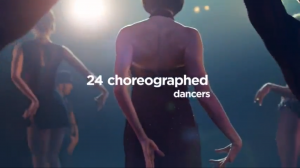“24 choreographed dancers? That’s the unlikely phrase the new Royal Carribbean Cruise line TV advertisement uses to bestow validity and power to the jazzy dance performances on its cruise ships. Has anyone seen such language before? Since when did “choreographed” become Madison Avenue’s go-to adjective for teasing a populist dance performance?
The TV dance competitions all speak regularly of choreography these days, but my overpowering association with the word “choreography” this year is its pivotal role in the recent New York State Court of Appeals ruling on taxation issues at an Albany strip called Nite Moves. In the well-covered case, the majority opinion determined that the lap dances and private-room ‘performances’ at Nite Moves didn’t qualify as non-taxable “dramatic or musical arts performances” because they were not “choreographed.” This facet made them more akin to “entertainment” events like ball games and ice shows, the ruling said.
It sounds reasonable, but the ruling is being appealed for good reason. In the New York Times (which reported first on the initial hearing, then the ruling, then printed an editorial contesting the majority opinion), the editorial page writer argued that state tax law does not make a distinction on types of dance performed, highbrow or low. They favored Judge Robert L. Smith’s dissenting opinion, which “countered that the state regulation in question “assumes that ‘choreography’ includes all ‘dance routines’ — it does not matter what kind of dancing is being done.” In reporter James Barrows’ article, he wrote of the dissent: “Smith said the majority had ‘implicitly defined ‘choreographic performance’ to mean ‘highbrow dance’ or ‘dance worthy of a five-syllable adjective.'” The Times also pointed out Judge Smith’s assertion that “[the dances] were clearly planned, and it would be absurd to say that all improvised dance should be taxed. More important, he argued, ‘It does not matter if the dance was artistic or crude, boring or erotic. Under New York’s tax law, a dance is a dance.’”
Reading about all that brouhaha has certainly stuck with me. Now, when I’m watching the Royal Caribbean ad, with Flo Rida singing “I Get a Good Feeling” and the image of female backsides appears with the words “24 choreographed dancers” over it, all I see is an ad-man using ‘choreographed’ to telegraph “Highbrow! Highbrow! This is not a pole dance!”
Will it work? It may, but only for a while. According to the Times, “Nite Moves is planning to ask the appeals court to revisit this issue and, if it refuses, to ask the Supreme Court to review the case.”

Jean, I think that the word “choreographed” in that ad is meant merely to signal that these are dancers taking part in an organized piece of movement deliberately created for performance – rather than, say, 24 dancers going out and busting whatever moves they feel like on the dance floor in the ship’s nightclub.
Does that seem like stating the ridiculously obvious? Well, that ad’s target audience isn’t arts journalists. (We can’t afford cruises like that anyway.)
Perhaps this can be a useful reminder that not everyone makes the same assumptions or thinks within the same contexts as we do. I know I can always use reminders like that.
Hmm, maybe we should be emphasizing “choreographed ballets” in our ads from now on…!
I think it is right to distinguish between choreographed dance, including, I suppose, improvised dance following a set format to set or improvised music, and freely improvised dancing for personal purposes and commercial purposes, which would be free speech and work for hire. Otherwise you can copyright how you dance at a party. That is free movement speech. But if you create a specific move that others copy, it starts to enter another realm. The factor really is, is someone making money off of it? Then it is protected. The movement, that is.
What does this mean for freestyle performances? I’m not entirely thrilled about the idea of lawmakers deciding what dance is and isn’t based on choreography. I’m of the opinion that dance is dance.